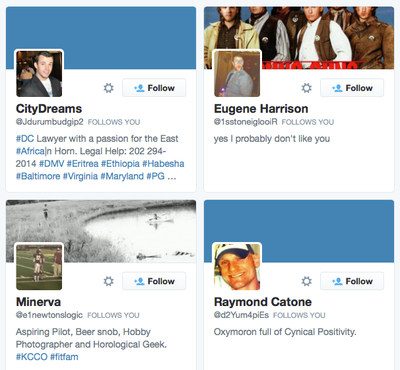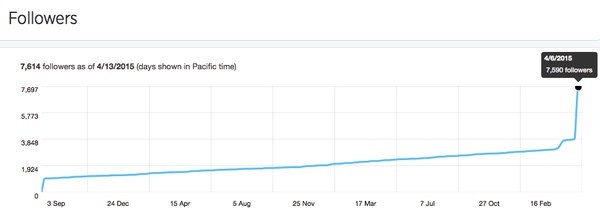This article was published in Scientific American’s former blog network and reflects the views of the author, not necessarily those of Scientific American
You're looking around on Twitter. There's an account that piques your interest: someone tweeting about quasars and Miami municipal politics, say. Or the dreamy paintings of Belgian Symbolist Fernand Khnopff and a smattering of amateur topiary photos. The interesting accounts have a couple of hundred tweets, yet tens of thousands of followers.
It's not hard to guess why the number of tweets combined with niche interests seem so incongruent with the follower count: they have probably falsely inflated their account with bot followers, fake accounts that are extremely cheap to purchase by the thousand.
.jpg?w=600)
The bot followers are coming! Image: © Glendon Mellow
On supporting science journalism
If you're enjoying this article, consider supporting our award-winning journalism by subscribing. By purchasing a subscription you are helping to ensure the future of impactful stories about the discoveries and ideas shaping our world today.
Spotting fakes
If you're not sure, there are a couple of ways to check.
One is the quality of followers you find with a quick scroll-through. Fakes can look pretty good, like these:

How did I guess these might be fake? Check out the @______ names. If I'm wrong, apologies.
Another way to check if someone is using bot followers is by using a free service like TweetAudit.com.

@Symbiartic and @FlyingTrilobite (my personal account) usually hover somewhere in the 90% real follower range. Sweet, thanks tweeps!
I assume algorithms by Tweet Audit and sites like it are not perfect: I have a good friend who is an egg, has an unusual name and never tweets. He uses Twitter to follow local news. He would probably identify as a fake. But overall, I have found it to be reflective of a general sense of real versus bot accounts.

Attacked by bots
Several weeks ago, while checking in with the @Symbiartic account I share with this site's co-bloggers Kalliopi Monoyios and Katie McKissick, I noticed something unusual. Our follower account had doubled.

The little bump on the far right was from the SciArt Tweet Storm: as the hub of the event, our account received its largest boost ever. But then doubling 3 weeks later...? Like, zoinks, Scoob.
My first thought was maybe it was due to the SciArt Tweet Storm at the beginning of March. But the timing was off, the surge in followers was 3 weeks later. I started scrolling through the followers list and seeing accounts like the examples above.
Around that time, I had had a private exchange with someone I will not name, arguing about fake followers. The conversation ended badly. Was this retaliation? I will probably never know. Symbiartic has had a Twitter account for almost 4 years, and my personal account has been around since 2009. This has never happened to me before. You pick up the odd fake here and there, everyone does. I do my best to block them when I see them but no doubt I have missed some. This was something else.
Scraping the bots off like barnacles
So. You're worried about having too many fakes. What do you do to get rid of them?
The first thing I did was tweet about the fakes from @Symbiartic. I wanted to get out in front of any potential accusations that we were inflating our account in search of elusive prestige.
The @Symbiartic crew are aware we've been the target of a large amount of spam followers recently and are working to fix this situation.
— Symbiartic SciArt (@Symbiartic) April 14, 2015Unfortunately, in the Twitter desktop site, it takes about 3 clicks to block someone, effectively stopping them from following you. With thousands of fakes, it's a huge time sink and strain on your wrist to get rid of them.
So I read a few blogs about it, and decided to use Manageflitter's paid service. I use the free version from time to time to identify accounts that are dormant and unfollow. But to view which ones Manageflitter views as fake (each with a percentage rating) you gotta pay.
Turns out you still have to manually unfollow them, but you can block each bot with one click of the mouse, and the list moves up so you're essentialy just tapping for an hour. Much faster than doing it the free way.
It didn't seem to get rid of the total number I was guessing were fake: before the attack we were somewhere over 3,900 followers. I logged back in a couple of weeks later and it identified another 500 more as fake, so clickity click, away they went. Now I'm relatively satisfied.

What's the big deal?
So why does it matter? So what if it makes someone else feel a false sense of importance? Isn't it just priming the pump, so to speak to attract new, real followers more quickly?
Perhaps. I find it displays a lack of integrity and a lack of respect for the hard work many people put into maintaining a social media account like Twitter over the years. I appreciate every real follower, and I think employing bots is arguably a disservice to the engaged (whether quiet or conversational) people who take the time to check out what we have to say.
On the flipside, our numbers are relatively modest. and getting rid of a few thousand was a pain, but not completely daunting. Fake follower accounts are growing more realistic all the time, following each other to appear more legitimate. So I am left with questions.
At what point does the number of real and fakes become too unwieldy to manage? With 10,000 followers? 500,000?
And how responsible are you when someone unknown party has unleashed a torrent of them upon your account? If this happened weekly, it would be not only an investment of time, but of money since it costs to enable the tools that allow you to get rid of them.
I never want to be broken to the point of saying "All hail our spammy bot overlords".
_______________
Share your bot follower stories in the comments and on Twitter with @Symbiartic.